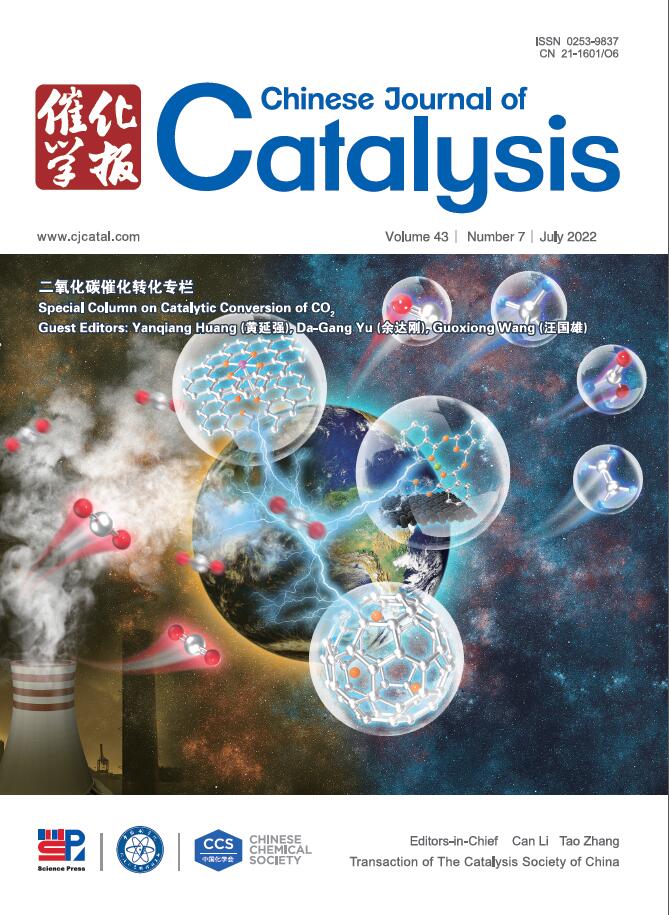s -方案异质结光催化剂的太阳能驱动H2O2生产
IF 17.7
1区 化学
Q1 CHEMISTRY, APPLIED
引用次数: 0
摘要
过氧化氢(H2O2)作为一种重要的绿色化工原料,在能源和环境领域有着广泛的应用。然而,生产H2O2主要依靠蒽醌法,这是一个能源密集型的方法,涉及多步反应,产生有害的副产物废物。太阳能驱动的H2O2生产是H2O2产生的另一种途径,是一种绿色和可持续的技术,因为它只使用水和氧气作为原料。然而,电荷载体的快速重组和氧化还原能力不足限制了光催化生产H2O2的性能。构建阶梯结构(S-scheme)异质结光催化剂被认为是解决这些缺陷的有效策略,因为它不仅实现了空间上的电荷载流子分离,而且还保持了光催化体系的氧化还原能力。本文综述了s型异质结制H2O2光催化剂的基本原理、表征技术和制备策略等方面的研究进展。系统地讨论了s型异质结光催化生成H2O2的机理和优点。综述了近年来的s型异质结设计,包括无机-有机异质结、无机-无机异质结和有机-有机异质结。最后,提出了s型光催化剂制备H2O2的挑战和研究方向。本文章由计算机程序翻译,如有差异,请以英文原文为准。
Solar-driven H2O2 production by S-scheme heterojunction photocatalyst
Hydrogen peroxide (H2O2), as an essential and green chemical, is extensively used in energy and environmental applications. However, the production of H2O2 primarily relies on the anthraquinone method, which is an energy-intensive method involving multi-step reactions, producing harmful by-product wastes. Solar-driven H2O2 production, an alternative route for H2O2 generation, is a green and sustainable technology since it only utilizes water and oxygen as feedstock. However, the rapid recombination of charge carriers as well as insufficient redox capability limit the photocatalytic H2O2 production performance. Constructing step-scheme (S-scheme) heterojunction photocatalysts has been regarded as an effective strategy to address these drawbacks because it not only achieves spatially separated charge carriers, but also preserves redox capability of the photocatalytic system. This paper covers the recent advances of S-scheme heterojunction photocatalysts for H2O2 production in terms of basic principles, characterization techniques, and preparation strategies. Moreover, the mechanism and advantages of S-scheme heterojunction for photocatalytic H2O2 generation are systematically discussed. The recent S-scheme heterojunction designs, including inorganic-organic heterojunction, inorganic-inorganic heterojunction, and organic-organic heterojunction, are summarized. Lastly, the challenges and research directions of S-scheme photocatalysts for H2O2 generation are presented.
求助全文
通过发布文献求助,成功后即可免费获取论文全文。
去求助
来源期刊

Chinese Journal of Catalysis
工程技术-工程:化工
CiteScore
25.80
自引率
10.30%
发文量
235
审稿时长
1.2 months
期刊介绍:
The journal covers a broad scope, encompassing new trends in catalysis for applications in energy production, environmental protection, and the preparation of materials, petroleum chemicals, and fine chemicals. It explores the scientific foundation for preparing and activating catalysts of commercial interest, emphasizing representative models.The focus includes spectroscopic methods for structural characterization, especially in situ techniques, as well as new theoretical methods with practical impact in catalysis and catalytic reactions.The journal delves into the relationship between homogeneous and heterogeneous catalysis and includes theoretical studies on the structure and reactivity of catalysts.Additionally, contributions on photocatalysis, biocatalysis, surface science, and catalysis-related chemical kinetics are welcomed.
 求助内容:
求助内容: 应助结果提醒方式:
应助结果提醒方式:


